Technical standard
ROAD STRUCTURE ORDINANCE
(Government Ordinance No.320 of 29 October, 1970)
(Sidewalks)
Article 11
1. A sidewalk shall be provided on both sides of Type 4 roads (excluding those roads provided with bicycle/pedestrian tracks), Type 3 roads (except for Class 5 and excluding those roads provided with bicycle/pedestrian tracks) with higher pedestrian traffic volume or Type 3 roads already provided with bicycle tracks or bicycle traffic lanes, except where topographical conditions or any other reasons prevent such provision.
2. Sidewalks shall be provided on Type 3 roads (excluding those roads already provided with bicycle/pedestrian tracks and those roads stipulated in the preceding paragraph) where it is required for safe and smooth traffic, except where topographic conditions or any other reasons do not permit such provision.
3. The sidewalk width shall be wider than 3.5m for roads with higher pedestrian traffic volume and wider than 2m for other roads.
4. Where pedestrian bridges etc. or on-street facilities are provided, bicycle/pedestrian track width shall be increased by 3m where pedestrian bridges etc. are to be constructed, 2m where a roofed bench is to be installed, 1.5m where a row of trees is to be planted, 1m where a bench is installed or 0.5m in other cases, respectively to the values given in the preceding paragraph, and requirements as specified above shall be applied, except for Type 3 Class 5 roads where topographic conditions or other special reasons do not permit such provisions.
5. The sidewalk width shall be determined in consideration of pedestrian traffic conditions on the roads.
(Waiting Area for Pedestrians)
Article 11-2
Waiting space for pedestrians shall be provided on sidewalks, bicycle-and pedestrian tracks, bicycle-and pedestrian paths or exclusive pedestrian roads, in the case that it is necessary to ensure that the safe and smooth passage of pedestrians or bicycle riders will not be impeded due to the accumulation of pedestrians at the pedestrian crossings or at bus stops.
(Center Strip Width in Snowy Areas)
Article 11-3
Center strip, shoulder, bicycle/pedestrian track and side walk width in snowy areas shall be determined in consideration of snow removal.
(Planting Strip)
Article 11-4
1. The planting strip shall be provided to Type 4 Class 1 and Class 2 roads and if necessary to other roads, except where topographic conditions or other special reasons do not permit such provisions.
2. The planting strip width standard shall be 1.5m.
3. The planting strips provided between road sections as described
below shall have proper width values, exceeding values specified
in the sect ion above when requi red for condi t ions in
comprehensive consideration of road structure, traffic condition,
and land use of adjoining areas and other measures taken to
improve road traffic environment or to ensure a better living
environments along adjoining areas irrespective of the
requirements above:
1) Sections of arterial roads and central business districts in large
cities running through scenic spots.
2) Sections of arterial roads running through residential areas or
areas that are expected to become residential.
4. For planting strips, the selection of plant species and arrangement of trees shall take into account with the ecological characteristics of the area.
(Clearances)
Article 12
Clearances on roads shall be shown in Fig.1 for carriageways and in Fig.2 for sidewalks and bicycle tracks or bicycle/pedestrian tracks (hereinafter referred to as "bicycle tracks").
Fig.1
| (1) | (2) | (3) | |||||||||||||||||||||||||||||||||||||||||||
| Carriageway of roads where the shoulder is provided by connecting with the carriageway [except for the road sections specified in (3)] | Carriageway of roads where the shoulder is not provided by connecting with the carriageway[except for the road sections specified in (3) ] | Of carriageway, secions related to Separator or Island | |||||||||||||||||||||||||||||||||||||||||||
| Carriageway of roads other than tunnels without sidewalk or bicycle track, bridge longer than 50m or viaduct | Carriageway in tunnels without sidewalk or bicycle track, on bridges longer than 50m or viaduct | ||||||||||||||||||||||||||||||||||||||||||||
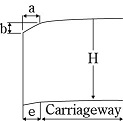
|
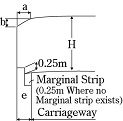
|
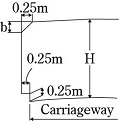
|
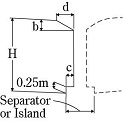
|
||||||||||||||||||||||||||||||||||||||||||
|
In this figure, H, a, b, c, d and e indicate the following values. H: 4.8m for regular motor vehicle roads designated as part of the primary highway freight network, 4.5m for other regular motor vehicle roads and 3m for smaller motor vehicle roads except for Type 3 Class 5 regular motor vehicle roads (except for regular motor vehicle roads designated as part of the primary highway freight network) where the value may be reduced to 4m in unavoidable cases such as for a topographical reason (or 3m when traffic volume of large-sized motor vehicles is extremely small and these may access neighboring bypass roads). a: The width of the shoulder connected with the carriageway on regular motor vehicle roads (for shoulders where on-street facilities are provided, shoulder width minus value required for on-street facilities), provided that the value exceeds 1m shall be 1m. The width of the shoulder connected with the carriageway on smaller motor vehicle roads shall be 0.5m. b:Value subtracting 4.1m from H (regarded as 4.1m where H is less than 4.1m) for regular motor vehicle roads designated as part of the primary highway freight network, 3.8m from H (regarded as 3.8m where H is less than 3.8m) for other regular motor vehicle roads, and shall be 0.2m for smaller motor vehicle roads. c and d: Concerning the separator, values listed in columns c and d in accordance with road classification and concerning the island, the value of c shall be 0.25m and the value of d shall be 0.5m.
e: Width of the shoulder connected with the carriageway (for shoulders where on-street facilities are provided, shoulder width minus value required for on-street facilities). |
|||||||||||||||||||||||||||||||||||||||||||||
Fig. 2
| Sidewalk or bicycle track without On-street facilities | Sidewalk or bicycle track with On-street facilities |
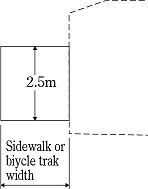 | 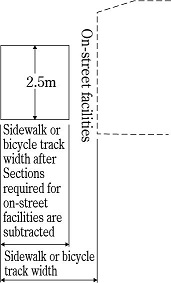 |
(Design Speed)
Article 13
1. Design speed on roads, except for service roads, shall be the
values listed in the left column of the following table, in
accordance with road classification, except where topographical
conditions or any other reasons do not permit such provisions.
Design speed on roads may be the values listed in the right
column of the same table when dealing with these exceptions,
however this does not apply to Type 1 Class 4 roads that are
national expressways.
2. Design speed on the service roads shall be 40km, 30km, or 20km per hour.
| Classification | Design Speed (km/h) | ||
| Type1 | Class 1 | 120 | 100 |
| Class 2 | 100 | 80 | |
| Class 3 | 80 | 60 | |
| Class 4 | 60 | 50 | |
| Type2 | Class 1 | 80 | 60 |
| Class 2 | 60 | 50 or 40 | |
| Type3 | Class 1 | 80 | 60 |
| Class 2 | 60 | 50 or 40 | |
| Class 3 | 60,50 or 40 | 30 | |
| Class 4 | 50,40 or 30 | 20 | |
| Class 5 | 40,30 or 20 | ||
| Type4 | Class 1 | 60 | 50 or 40 |
| Class 2 | 60,50 or 40 | 30 | |
| Class 3 | 50,40 or 30 | 20 | |
(Carriageway Bend Section)
Article 14
Carriageway bend sections shall be curved in shape, except for transition sections, (hereinafter indicating certain sections, provided at the carriageway bend sections, that allow for smooth vehicle traffic) or bend sections provided pursuant to the provision of Article 31.2.
(Radius of Curve)
Article 15
Radii of curve at the centerline of the carriageway (hereinafter referred to as "radius of curve"), except for transition sections, (hereinafter referred to as "carriageway curve section") shall not be less than the values as listed in the left column of the following table according to design speed, except when unavoidable due to, for example, topographical reasons, in which case the radii of curve may be reduced to the values as listed in the right column of the same table.
| Design Speed (km/h) | Radius of Curve (m) | |
| 120 | 710 | 570 |
| 100 | 460 | 380 |
| 80 | 280 | 230 |
| 60 | 150 | 120 |
| 50 | 100 | 80 |
| 40 | 60 | 50 |
| 30 | 30 | |
| 20 | 15 | |
(Superelevation at Curve Section)
Article 16
Appropriate Superelevation with no more than the values as listed in the right column of the following table (6% for Type 3 roads without bicycle track) shall be provided on curves of the carriageway, the center strip (except divider), and the shoulder connected with the carriageway, according to road classification and degree of snow fall or cold climate in the areas where the roads are located, in consideration of design speed, radii of curve, and topographical conditions, unless the radius of the curve is too large, except for Type 4 roads which can be omitted in such unavoidable cases as topographical conditions or any other reasons.
| Classification | Area Where Road is Located | Maximum Super-elevation (%) | |
| Type 1,2 and 3 | Snowy or Cold Area | Severely Snowy or Cold Area | 6 |
| Other Areas | 8 | ||
| Other Areas | 10 | ||
| Type4 | 6 | ||
(Widening Lane at Curve Section)
Article 17
The lane width on carriageway curve sections (or carriageway width in the case of roads without lanes) shall be appropriately widened except for Type 2 and 4 roads, where topographical conditions or any other reasons do not permit such provisions.
(Transition Section)
Article 18
1. Transition sections shall be provided on carriageway bend sections for Type 4 roads where topographical conditions or any other reasons do not permit such provisions.
2. When a curved section is widened and/or provided with Superelevation, a runoff for this widening and/or Superelevation shall be completed in the transition section.
3. The transition curve length shall not be less than the right side value as listed in the following table according to design speed (or length required for runoff when length required for runoff as specified in Section above exceeds values as listed in the same column).
| Design Speed (km/h) | Transition Section Length (m) |
| 120 | 100 |
| 100 | 85 |
| 80 | 70 |
| 60 | 50 |
| 50 | 40 |
| 40 | 35 |
| 30 | 25 |
| 20 | 20 |
(Sight Distance)
Article 19
1. Sight distance shall not be less than the values below, as listed in the following table according to design speed.
2. For roads with two lanes (except for one-way roads), sufficient sections of oncoming highway visible to the driver shall be provided for overtaking.
| Design Speed (km/h) | Transition Section Length (m) |
| 120 | 210 |
| 100 | 160 |
| 80 | 110 |
| 60 | 75 |
| 50 | 55 |
| 40 | 40 |
| 30 | 30 |
| 20 | 20 |
(Grades)
Article 20
Carriageway grades shall be no more than the values listed in the left grade column of the following table according to road classification and design speed, except where topographical conditions or any other reasons do not permit such provisions; in such cases the values of the grade may be reduced to the values listed in the right grade column of the same table.
| Classification | Design Speed (km/h) | Grade (%) | ||
| Type 1, Type 2 & Type3 | Regular motor vehicle roads | 120 | 2 | 5 |
| 100 | 3 | 6 | ||
| 80 | 4 | 7 | ||
| 60 | 5 | 8 | ||
| 50 | 6 | 9 | ||
| 40 | 7 | 10 | ||
| 30 | 8 | 11 | ||
| 20 | 9 | 12 | ||
| Smaller motor vehicle roads | 120 | 4 | 5 | |
| 100 | 4 | 6 | ||
| 80 | 7 | |||
| 60 | 8 | |||
| 50 | 9 | |||
| 40 | 10 | |||
| 30 | 11 | |||
| 20 | 12 | |||
| Type 4 | Regular motor vehicle roads | 60 | 5 | 7 |
| 50 | 6 | 8 | ||
| 40 | 7 | 9 | ||
| 30 | 8 | 10 | ||
| 20 | 9 | 11 | ||
| Smaller motor vehicle roads | 60 | 8 | ||
| 50 | 9 | |||
| 40 | 10 | |||
| 30 | 11 | |||
| 20 | 12 | |||
